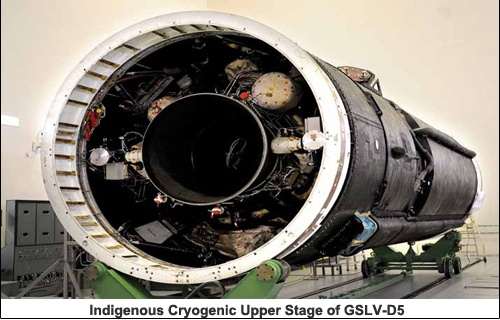The Cryogenic Rocket Engine or the CE-20 is basically a subsidiary of ISRO or the Indian Space Research Organization. It was developed and designed by the Liquid Propulsion Systems Center (LPSC).
ISRO has been developing a Cryogenic Engine with a high thrust that can be utilized for the upper stage of the launch vehicle (heavy lift), i.e., GSLV Mk-III. This cryogenic engine with high thrust easily generates 196.5 kN of nominal thrust in a vacuum in addition to 434 seconds of specific impulse. The cryogenic engine works on the “Gas Generator Cycle.” This cycle has the flexibility for being developed independently prior to the integrated engine test of each sub-system. This goes a long way to reducing uncertainty when it comes to the final developmental phase as well as the development time.
The cryogenic engine is also responsible for producing almost 2 MW of power as opposed to the Cryogenic Upper Stage (CUS) engine that produces only 1 MW of power. Therefore, the cryogenic engine of high thrust can easily be regarded as one of the most powerful and robust engines that belong to the upper stages throughout the world.
ISRO also went on to conduct a ground test of the Indigenous Cryogenic Engine (High Thrust) on 28th April 2015 at the Propulsion Complex of ISRO at Mahendragiri. This ground test took place for 635 seconds at 1657 hours and is considered to be a major feat in the history of ISRO. It is also noteworthy that the entirety of the propulsion parameters was found satisfactory during the test and they also matched with the predictions closely. Prior to these ground test approximately a few weeks before, four other short duration tests lasted 5.5, 7.5, 20 as well as 30 seconds.
The Liquid Propulsion Systems Center (LPSC) situated at Valiamala have designed as well as realized this high thrust cryogenic engine with the active support of VSSC or Vikram Sarabhai Space Center at Thiruvananthapuram. The engine integration, testing as well as the assembly is carried out at Mahendragiri by the ISRO Propulsion Complex (IPRC). In addition to that, countless Indian industries have also gone out of their way to contribute significantly to the realization and success of the cryogenic engine.
Many ground tests have been conducted to date that validate the design, performance, and adequacy of the integrated engine. Several other demonstration tests have also been planned at the stage and engine level in order to characterize the distinct performance parameters that fall under a variety of operating conditions. It is planned that once these tests are completed, the indigenous cryogenic engine (high thrust), as well as the stage, will be flight tested in the mission of GSLV Mk – III – D1.
The Search For CE-20
ISRO started the GSLV program in response to the mounting communication requirements of India. The government approved the second-generation series of satellites of INSAT-2 in 1987 that weighed over 2 tons. ISRO also wanted to develop and design a class of satellites that weigh 2.5 tons and place them in the geostationary transfer orbit situated at a distance of 36,000 km from the Earth’s surface. In addition to that, ISRO also intended to create a lighter, bigger as well as more efficient vehicle than the Polar Satellite Launch Vehicle (PSLV) that is its workhorse. There was a total of three fuel options available namely cryogenic, semi-cryogenic and earth storable.
Cryogenic Engines use liquid oxygen and liquid hydrogen as a fuel in order to provide the maximum amount of thrust possible. They are, more often than not, ready for the “upper stages” as well as the last rocket stage as this is the stage that delivers 50% of the total 10.2 km/s velocity that is required at the time of satellite injection. ISRO scientists also started developing a cryogenic engine of 1 ton in 1986 at ₹12 crores. They wanted to understand exactly how to handle liquid oxygen as well as liquid nitrogen. At the same time, ISRO also formed a design team at Mahendragiri, Tamil Nadu at the Liquid Propulsion Center. They intended to design a turbo-fed engine of 7 tons. This development went a long way to boost the confidence of the engineers of ISRO, and the organization knew that they could not wait any longer to design and develop the indigenous engine.
Final Words
ISRO has managed to perform amazing feats when it comes to outer space. The cryogenic engine is one such achievement that helped scientists and researchers discover several things and get answers to many questions that had been plaguing them for a long time. The achievements of ISRO as an organization are because of its constant thirst of growth and finding answers to the unknown entities of the world. Their list of successes is only expected to increase in the future.





